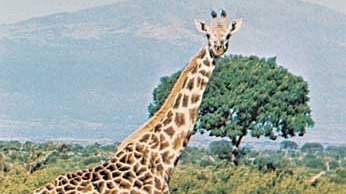Hadithi
HISTORIA YA TWIGA

giraffe, (genus Giraffa), any of four species in the genus Giraffa of long-necked cud-chewing hoofed mammals of Africa, with long legs and a coat pattern of irregular brown patches on a light background. Giraffes are the tallest of all land animals; males (bulls) may exceed 5.5 metres (18 feet) in height, and the tallest females (cows) are about 4.5 metres. Using prehensile tongues almost half a metre long, they are able to browse foliage almost six metres from the ground. Giraffes are a common sight in grasslands and open woodlands in East Africa, where they can be seen in reserves such as Tanzania’s Serengeti National Park and Kenya’s Amboseli National Park. The genus Giraffa is made up of the northern giraffe (G. camelopardalis), the southern giraffe (G. giraffa), the Masai giraffe (G. tippelskirchi), and the reticulated giraffe (G. reticulata).
Giraffes grow to nearly their full height by four years of age but gain weight until they are seven or eight. Males weigh up to 1,930 kg (4,250 pounds), females up to 1,180 kg (2,600 pounds). The tail may be a metre in length and has a long black tuft on the end; there is also a short black mane. Both sexes have a pair of horns, though males possess other bony protuberances on the skull. The back slopes downward to the hindquarters, a silhouette explained mainly by large muscles that support the neck; these muscles are attached to long spines on the vertebrae of the upper back. There are only seven neck (cervical) vertebrae, but they are elongated. Thick-walled arteries in the neck have extra valves to counteract gravity when the head is up; when the giraffe lowers its head to the ground, special vessels at the base of the brain control blood pressure.

